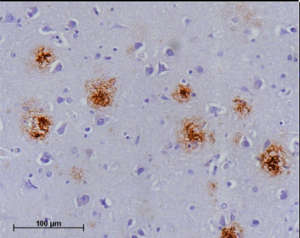Metal Ions and Alzheimer’s Disease
Metal-based Drugs for the Treatment of Neurodegenerative Disease
We are investigating the use of metal-based drugs for the treatment of neurodegenerative diseases including Alzheimer’s, Parkinson’s and Motor Neuron Disease.
Alzheimer’s disease is associated with the precipitation of insoluble aggregates of a peptide (called Aβ) that form plaques in the brain. These plaques are toxic and are thought to cause some of the symptoms of the disease. We are investigating copper and zinc complexes that are capable of breaking down the peptide and offer possibilities as new therapeutics.
Imaging Agents for the Diagnosis of Alzheimer’s Disease
We aim to prepare metal complexes with radioactive isotopes (Tc-99m, Cu-64, Ga-68) that bind selectively to protein deposits associated with neurodegenerative diseases. Such imaging agents have the possibility of improving the diagnosis of neurodegeneration and providing insight into the molecular nature of the conditions. In one program we are trying to make imaging agents that cross the blood-brain barrier and selectively bind to Aβ plaques that are associated with Alzheimer’s Disease.
The X-ray crystal structure of a Cu complex, CuL, designed to selectively bind to Aβ plaques.
Top: A section of human cortex from an AD subject with the Aβ plaques stained with an antibody. Bottom: The same Aβ palques stainied with CuL (visualised using fluorescence microscopy).


